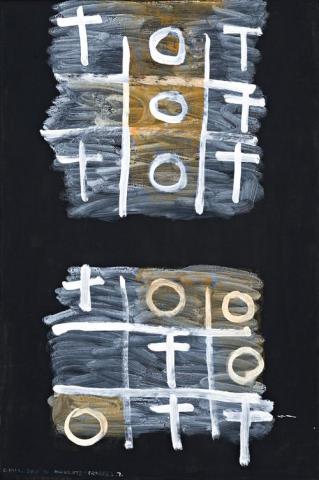NOUGHTS AND CROSSES 7, (THE FIRST SET), 1976
Colin Mccahon
acrylic on Steinbach paper mounted on board
109.5 x 73.0 cm
signed with initials lower left: 'C.McC'
inscribed lower centre: 'Noughts + Crosses.7'
Private Collection, Auckland
Private Collection, Brisbane
Martin Browne Fine Art, Sydney
The Collection of Andrew Upton and Cate Blanchett, Sydney
Colin McCahon Paintings, Barry Lett Galleries, Auckland, New Zealand , 23 August – 3 September 1976, cat. 1
Martin Browne Fine Art, Sydney
Colin McCahon: A Question of Faith, Stedelijk Museum, Amsterdam, The Netherlands, 30 August – 10 November 2002, and travelling to the City Gallery, Wellington, New Zealand; Auckland Art Gallery Toi o Tamaki, Auckland, New Zealand; National Gallery of Victoria, Melbourne; and Art Gallery of New South Wales, Sydney, 2002-2004.
Bloem, M. and Browne, M., Colin McCahon: A Question of Faith, Stedelijk Museum Amsterdam/Craig Potton Publishing, Nelson, New Zealand, p. 226, p. 134 (illus.)
Noughts and Crosses 7 is listed in The Colin McCahon Database and Image Library (www.mccahon.co.nz) as no. 001439.
The years 1975 and 1976 were extremely productive for Colin McCahon. A recurring theme from this period was what the artist saw as the 'sacred trust' laid upon a community to teach its young its way of life - notwithstanding that life can be unpredictable and difficult. The three multi-panel Teaching Aids, with their variations on the Stations of the Cross number combinations, were one group that attempted to give a visual reading of this issue: the two sets of Noughts and Crosses were another.
Inspiration for the Noughts and Crosses was provided by an everyday event. The idea for the paintings occurred to McCahon while watching his daughter Victoria play games of noughts and crosses with her young sons. In their discarded scraps of paper covered in completed games, McCahon found a rich metaphor for the universal 'game' of life. For in life, as in noughts and crosses, each individual must play within a given set of rules, the choices made and chances taken determining what follows thereafter.
Exploring the striking visual possibilities offered by the layout of the game, the artist produced a series of taut and unambiguous paintings in which this simple children's game became a diagram of life and death. Now the cross represented both a positive and affirmative act and, through the metaphor of the Crucifixion, the promise of redemption. As well as the 'x' traditionally used as the 'cross' in the game, in these paintings McCahon employs the shape of the Latin Cross - 't'- the Cross of Christ's crucifixion . By contrast, the noughts here threaten the possibility of the abyss; a primordial void from which there is no hope of escape.
The overall body of work known as Noughts and Crosses comprises 14 paintings (again, a reference to the 14 Stations of the Cross.) Within this group, the paintings are divided into two sets of 7 - known as 'the first set' and 'series 2'. Each of the paintings in 'the first set' depicts two completed games of noughts and crosses whereas the iconography in 'series 2' is, in each case, a single game. A uniform feature of all the 'first set' games is the victory of the crosses - and always the cross used is the Latin Cross of the Crucifixion rather than an 'x'. The sole exception to this rule is in the upper game of the work illustrated here - number 7, the last in 'the first set'. This game is unusual because in it there is a win for both the noughts and the crosses - something that would never happen in a real game, where the first to get a complete line of three wins. But in the lower game - the final one in the first set - victory again lies with the Latin Crosses.
Noughts and Crosses 7 is also exceptional among 'the first set' in that McCahon has introduced washes of sepia to iconography that in the preceding paintings had been almost totally black and white. This introduction of colour presaged the bold yellows, greys and blacks of the seven works in series 2.
Three of Noughts and Crosses (The First Set) are held by public museums - numbers 1 and 3 in the collection of the Auckland Art Gallery Toi o Tamaki and number 4 by the National Gallery of Australia, Canberra.
